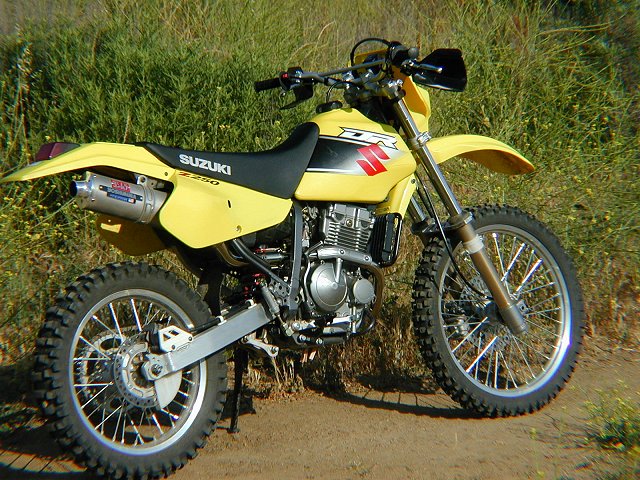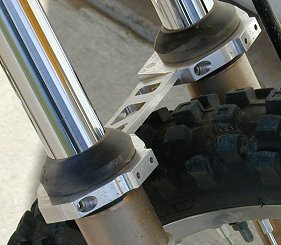
In our original test of the 2001 Suzuki DR-Z250, we pointed out that this bike sets new standards in the class (which includes Honda’s XR250 and Yamaha’s TTR250) in several categories. We also wanted to test Suzuki’s assertion that this was a bike that was beginner-friendly, but also a fun trail bike for experienced riders. Basically, we liked the stock bike, but wanted to see if some relatively low cost modifications could make it a bike better suited for faster, more experienced riders.
I am reminded that, years ago, one of the large print magazines ran a story about a test involving different size Honda XRs (I believe the test included an XR250, a big-bore XR280, an XR400 and an XR600). The magazine ran the various bikes through a woods course with riders of different skill levels, including former National champion, Scott Summers. To everyone’s surprise, the XR280 was the fastest bike through the course. There are two lessons here. First, in tight, woods riding, smooth power beats big power. Second, bikes with smaller motors and lighter cranks (regardless of overall bike weight) change direction easier and handle better in tight trails.
A 250 four-stroke can be a quick, competitive mount for an experienced rider, particularly with some minor modifications to engine and suspension. The Suzuki DR-Z250, with the modifications we tried, provided plenty of power for fast trail riding, and even for tight racing conditions. This bike is an excellent starting point for a beginner rider, and it clearly can grow with the rider’s experience level into a fun, tight-course race machine. Obviously, a 250 four-stroke is not going to be competitive racing in wide-open western conditions.
Since the DR-Z250 starts with a stiff, good-handling chassis, we wanted to focus on increasing engine performance and stiffening the soft front fork. We wanted to avoid spending a lot of money, as well.
The DR-Z250 comes with a very restricted intake. The airbox is choked off, and even removing the snorkel helps little. We cut a hole in the top of the airbox (about triple the size of the hole with the snorkel removed) to free the engine’s breathing. This made an immediate, noticeable difference, without modifying the stock exhaust system. This also required no jetting changes. The DR-Z250 comes jetted a bit rich to begin with, so this modification kept jetting within the ball park.
Next, we removed the stock exhaust system and bolted on Yoshimura’s new DR-Z250 full system. With larger diameter tubing and a freer flowing muffler, the Yoshimura exhaust makes a huge difference in power. The bike pulls much stronger off the bottom and through the mid-range. With the airbox modification, and the new pipe, we raised the carb needle one clip position, and richened the fuel screw one-quarter turn. We also bumped the main jet to the next richer size. Although we didn’t measure the db level, the Yoshimura is very quiet for an aftermarket system — much quieter than the Yoshimura slip-on muffler we tried on a DR-Z400 a year ago.
The stock forks are fully adjustable, as we discussed in our original review. They aren’t bad out of the box for basic trail riding, but they are too soft for larger, more experienced riders.
We didn’t want to send the suspension out for re-valving and re-springing. We wanted to see what we could do with basic modifications you can do in your garage. We began by adding 15cc of oil to each fork leg. This stopped the bottoming of the forks, but still left them relatively plush. Faster trail sections with whoops, for instance, can be handled with much greater control now.

We also bolted on a Summers Racing Components (SRC) fork brace. This took any noticeable flex out of the conventional 43mm fork tubes, and provided more precise steering and handling. SRC fork braces have been around for quite a while, and their quality and craftsmanship are excellent. Many riders claim that an SRC fork brace improves handling as much as, or more than, a more expensive steering stabilizer. SRC has an existing fork brace that happens to fit the new DR-Z250 model perfectly.
We then set the rear shock up with 95mm of sag, and dialed in compression and rebound for the individual test rider. The rear shock works reasonably well for trail riding, but may be the weak link for faster riders looking to race this bike. With the spring preload tightened to reach the correct sag, it was difficult to get the rear shock to follow the terrain on faster, choppier trails.
The bottom line is that the DR-Z250 can be modified to make fast guys happy on the trail. The stiff chassis and good quality components (for the class) make a great starting point for modifications. We can’t forget that electric start button, either.
Performance Products Used





